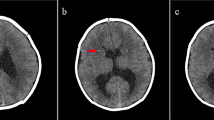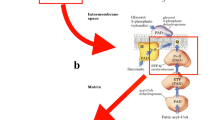Abstract
Propionic acidemia (PA) is a rare autosomal recessive organic aciduria resulting from defects in propionyl-CoA-carboxylase (PCC), a key enzyme of intermediate energy metabolism. PA mostly manifests during the neonatal period, when affected newborns develop severe metabolic acidosis and hyperammonemia. We present a previously healthy teenager, who suffered from acute fatigue and breathlessness. The patient was tachycardic, displayed a precordial heave and a systolic murmur. Cardiac investigations revealed severe dilated cardiomyopathy (DCM). Biochemical work up led to the diagnosis of PA. Remarkably, this patient of consanguineous Hispanic origin was in a good general health condition before the acute onset of DCM. Diagnosis of PA was confirmed by enzymatic and molecular genetic analysis, the latter revealing a novel homozygous mutation in the PCCB gene (c.1229G > A; p.R410Q). Residual PCC enzyme activity of approximately 14 % of normal was detected in patient’s lymphocytes and fibroblasts, thereby providing a possible explanation for the hitherto asymptomatic phenotype. Conclusion: Isolated DCM, although rare, can be the leading and/or sole symptom of late-onset PA. Therefore, patients with DCM should receive a comprehensive diagnostic evaluation including selective screening for inborn errors of metabolism.

Similar content being viewed by others
Abbreviations
- ADHS:
-
Attention deficit and hyperactivity syndrome
- DCM:
-
Dilated cardiomyopathy
- ECG:
-
Electrocardiography
- PA:
-
Propionic acidemia
- PCCA and PCCB:
-
Propionyl-CoA carboxylase subunits A and B
References
Baumgartner D, Scholl-Bürgi S, Sass JO, Sperl W, Schweigmann U, Stein JI, Karall D (2007) Prolonged QTc intervals and decreased left ventricular contractility in patients with propionic acidemia. J Pediatr 150:192–197
Fenton WA, Gravel RA, Rosenblatt DS (2001) Disorders of propionate and methylmalonate metabolism. In: Scriver CR, Beaudet A, Sly W, Valle D (eds) The Metabolic and Molecular Bases of Inherited Disease, 8th edn. McGraw-Hill, New York, pp 2165–2190
Gallego-Villar L, Perez-Cerda C, Perez B, Abia D, Ugarte M, Richard E, Desviat LR (2012) Functional characterization of novel genotypes and cellular oxidative stress studies in propionic acidemia. J Inherit Metab Dis 36:731–740
Grünert SC, Müllerleile S, De Silva L, Barth M, Walter M, Walter K, Meissner T, Lindner M, Ensenauer R, Santer R, Bodamer OA, Baumgartner MR, Brunner-Krainz M, Karall D, Haase C, Knerr I, Marquardt T, Hennermann JB, Steinfeld R, Beblo S, Koch HG, Konstantopoulou V, Scholl-Bürgi S, van Teeffelen-Heithoff A, Suormala T, Sperl W, Kraus JP, Superti-Furga A, Schwab KO, Sass JO (2013) Propionic acidemia: clinical course and outcome in 55 pediatric and adolescent patients. Orphanet J Rare Dis 8:6
Lee TM, Addonizio LJ, Barshop BA, Chung WK (2009) Unusual presentation of propionic acidaemia as isolated cardiomyopathy. J Inherit Metab Dis 32(Suppl 1):S97–S101
Mardach R, Verity MA, Cederbaum SD (2005) Clinical, pathological, and biochemical studies in a patient with propionic acidemia and fatal cardiomyopathy. Mol Genet Metab 85:286–290
Massoud AF, Leonard JV (1993) Cardiomyopathy in propionic acidaemia. Eur J Pediatr 152:441–445
Nymark TB, Hovland A, Bjornstad H, Nielsen EW (2008) A young man with acute dilated cardiomyopathy associated with methylphenidate. Vasc Health Risk Manag 4:477–479
Romano S, Valayannopoulos V, Touati G, Jais JP, Rabier D, de Keyzer Y, Bonnet D, de Lonlay P (2010) Cardiomyopathies in propionic aciduria are reversible after liver transplantation. J Pediatr 156:128–134
Suormala T, Wick H, Bonjour JP, Baumgartner ER (1985) Rapid differential diagnosis of carboxylase deficiencies and evaluation for biotin-responsiveness in a single blood sample. Clin Chim Acta 145:151–162
Yang X, Sakamoto O, Matsubara Y, Kure S, Suzuki Y, Aoki Y, Yamaguchi S, Takahashi Y, Nishikubo T, Kawaguchi C, Yoshioka A, Kimura T, Hayasaka K, Kohno Y, Iinuma K, Ohura T (2004) Mutation spectrum of the PCCA and PCCB genes in Japanese patients with propionic acidemia. Mol Genet Metab 81:335–342
Acknowledgments
This work has been supported by radiz—Rare Disease Initiative Zurich, a clinical research priority program of the University of Zurich. We would like to thank Corinne Britschgi and Seraina Lutz for technical support with molecular genetic analysis of PCCB gene and PCC activity assays, respectively.
Conflict of interest
None.
Author information
Authors and Affiliations
Corresponding author
Additional information
Communicated by Beat Steinmann
Rights and permissions
About this article
Cite this article
Laemmle, A., Balmer, C., Doell, C. et al. Propionic acidemia in a previously healthy adolescent with acute onset of dilated cardiomyopathy. Eur J Pediatr 173, 971–974 (2014). https://doi.org/10.1007/s00431-014-2359-6
Received:
Revised:
Accepted:
Published:
Issue Date:
DOI: https://doi.org/10.1007/s00431-014-2359-6




